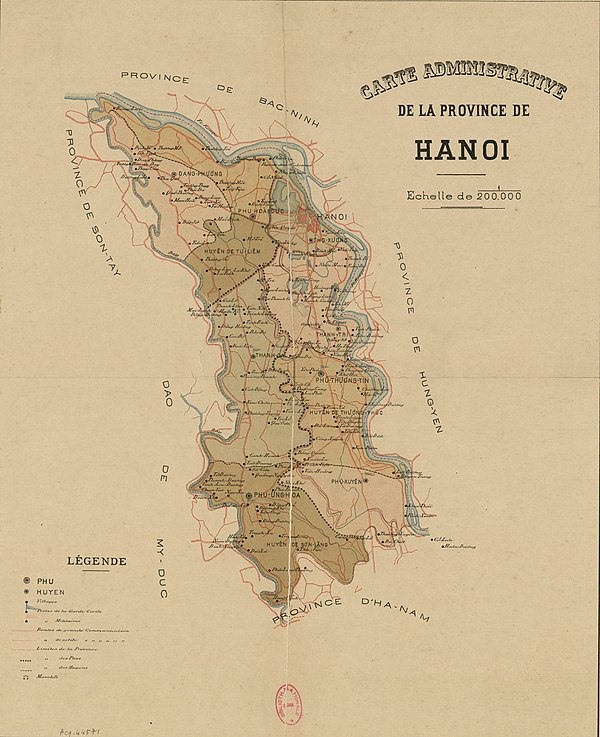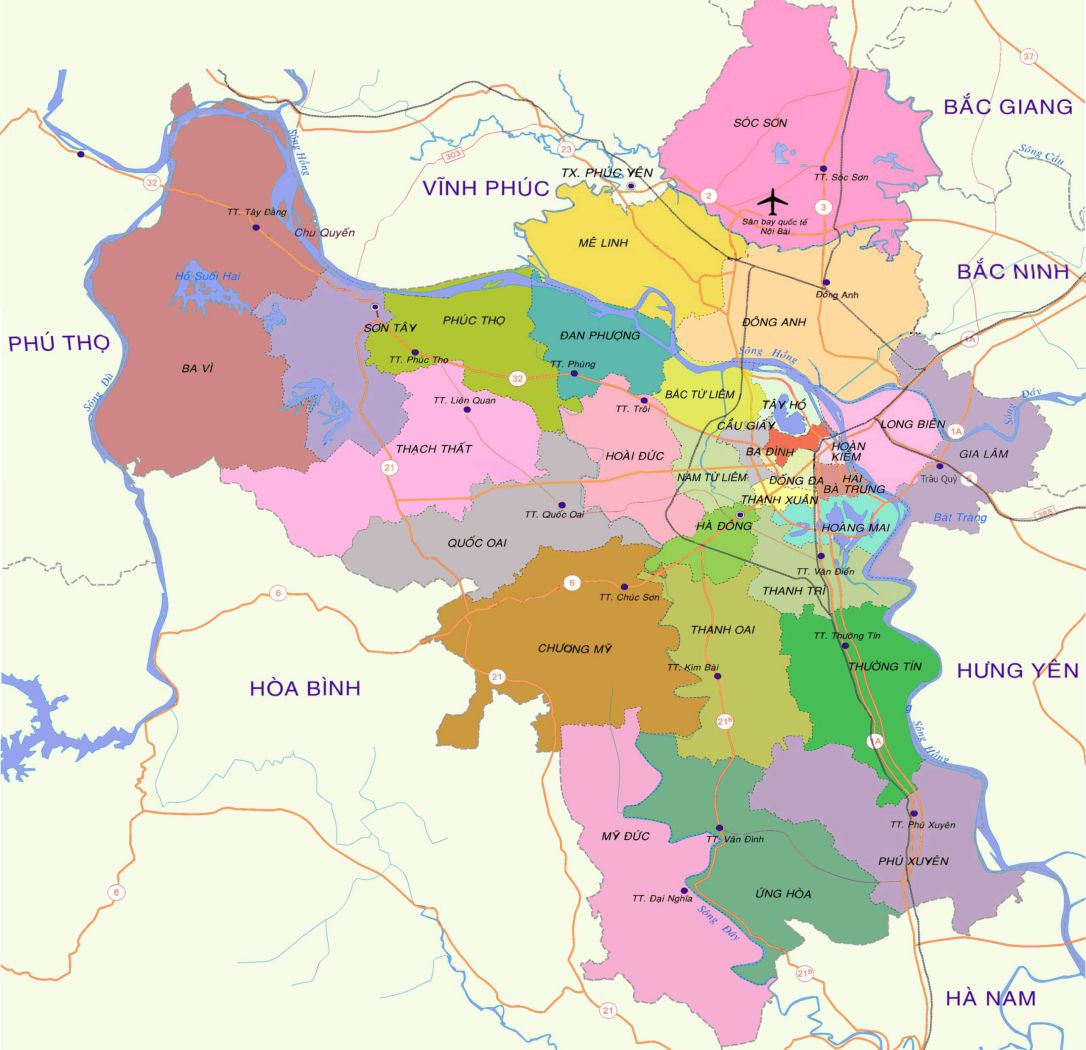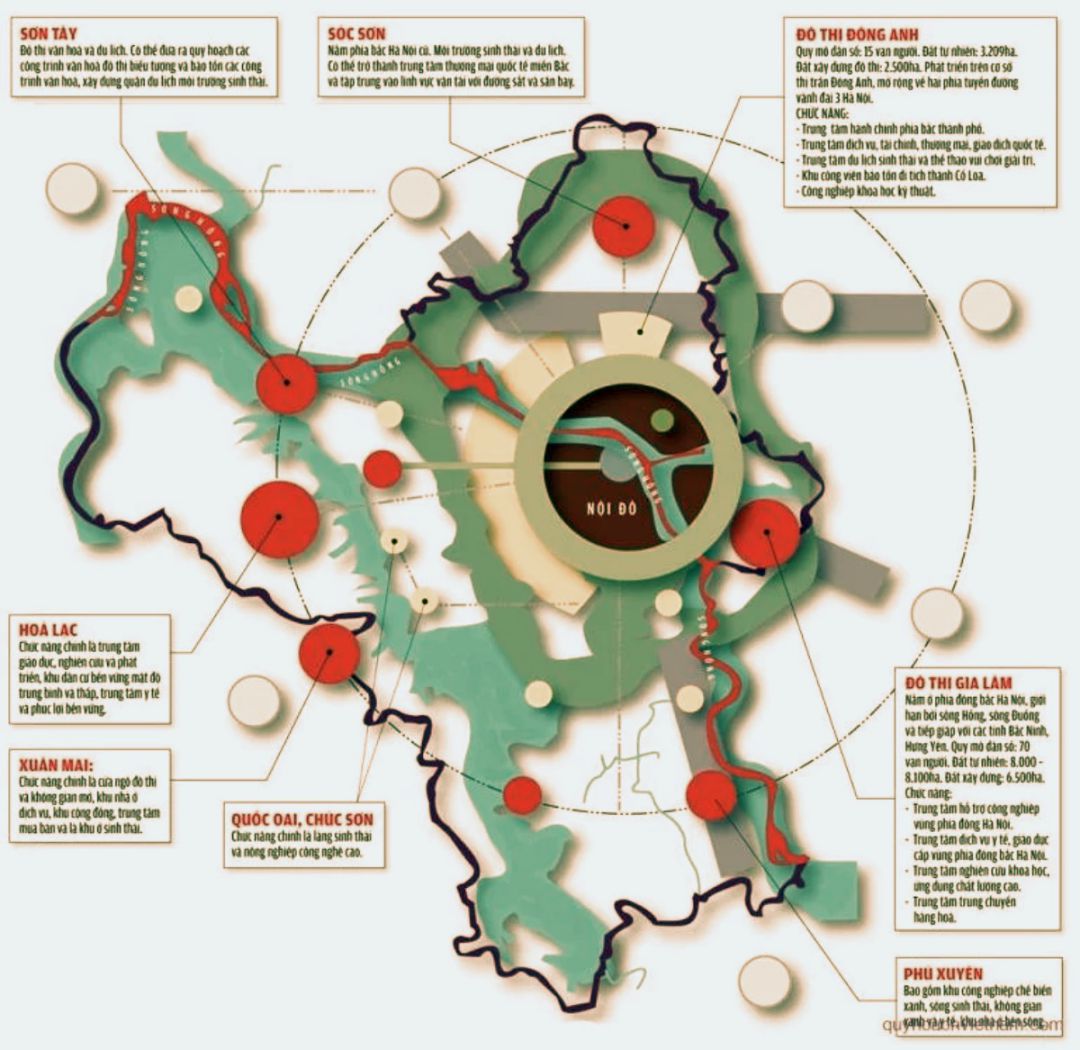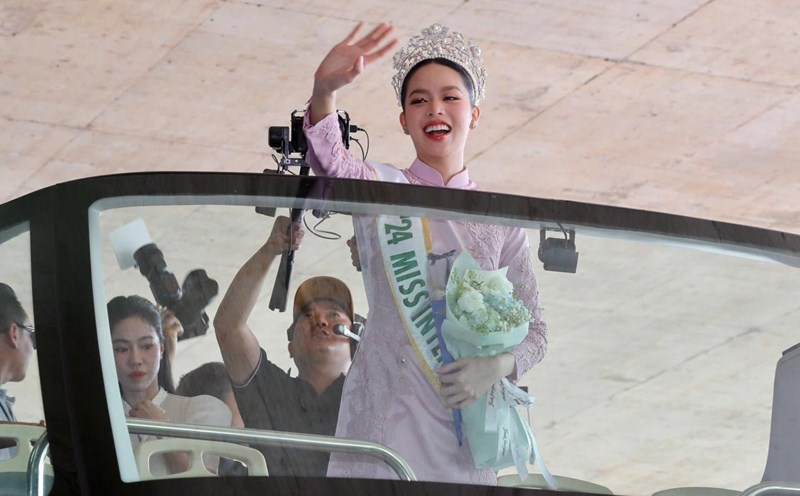That's right, Hanoi is the capital and for a long time, people have compared the capital to the heart of a country. And musician Nguyen Duc Toan wrote the famous song "Hanoi - Pink Heart" in 1987.
However, the Heart - Hanoi does not stop at the meaning of a symbol, but the living space and shape of Hanoi today literally bears the shape of a heart. Hanoi is perhaps the only capital in the world that is a "heart" in both the figurative and literal sense.
Hanoi of yesterday
The appearance of Hanoi changed over time. According to historian Duong Trung Quoc: “When the French occupied Hanoi for the second time (1883) and forced the Royal Court to gradually surrender, the landscape around the lake and Hanoi as a whole was only a ruined city after 8 decades of the capital being moved deep into Hue. According to this map, the northern border with Hanoi province is Truc Bach lake, the southern border is the Don Thuy concession area, the western border is Hanoi citadel and the Temple of Literature. The area in the early period was 945 hectares with a population of about 100,000 people.
The archives still preserve a French project established in 1884 (that is, the time when the Hue Court had just signed a treaty establishing the protectorate of France over the entire Central and Northern regions) and 4 years before the court granted the land as a concession, the land around Hoan Kiem Lake was chosen as the center of the city that France would build as both the capital of the entire Northern region and the headquarters of Hanoi City. On July 19, 1888, Governor-General Richaud signed a decree establishing Hanoi City regarding the organizational and management structure, but it was not until October 1888 that King Dong Khanh issued an edict regarding the granting of land to France as concessions in many areas, including Hanoi, Hai Phong and Da Nang (Tourane). From that time on, Hanoi City was officially established and from the core with Hoan Kiem Lake as the center, a colonial urban area began to take shape according to a very methodical roadmap and planning".
On September 2, 1945, at Ba Dinh Square, President Ho Chi Minh read the Declaration of Independence, giving birth to the Democratic Republic of Vietnam. By choosing Hanoi as the place to read the Declaration of Independence, the great leader of the Vietnamese revolution - President Ho Chi Minh and the Provisional Revolutionary Government at that time intended to choose Hanoi as the capital of the Democratic Republic of Vietnam.
On November 9, 1946, at the second session of the 1st National Assembly, the 1946 Constitution was passed. In Chapter 1 of the Government, Article 3 of the Constitution stated: "The flag of the Democratic Republic of Vietnam has a red background and a five-pointed yellow star in the middle. The national anthem is the Marching Song. The capital is Hanoi."

Thus, it can be considered that from November 9, 1946, Hanoi was officially the capital of the Democratic Republic of Vietnam. In 1976, the National Assembly of unified Vietnam decided to change the country's name to the Socialist Republic of Vietnam; right at the first session of the National Assembly, term IV, Hanoi was honored to be chosen as the capital of the Socialist Republic of Vietnam until today.
Hanoi's boundaries were also expanded. On October 10, 1954, Hanoi was completely liberated. On November 4, 1954, Hanoi officially established the district administrative committees. At that time, Hanoi had 4 inner-city districts with 34 neighborhoods and 4 suburban districts with 46 communes, with a total area of about 130 km² and a population of about 380,000 people.
In 1978, the Vietnamese National Assembly approved the expansion of Hanoi's boundaries, merging five more districts: Ba Vi, Thach That, Phuc Tho, Dan Phuong, Hoai Duc and Son Tay town of Ha Son Binh province, along with two districts of Vinh Phu province: Me Linh and Soc Son.
In 1991, Hanoi's boundaries were adjusted again, transferring 5 districts and 1 town taken from Ha Son Binh in 1978 to Ha Tay and Me Linh was merged into Vinh Phuc province. Hanoi had 4 inner-city districts and 5 suburban districts remaining, with a natural land area of 924 km2.
And in May 2008, the Vietnamese National Assembly passed a resolution to adjust the administrative boundaries of Hanoi Capital and the provinces: The entire Ha Tay province, Me Linh district of Vinh Phuc province and 4 communes of Luong Son district, Hoa Binh province were merged into Hanoi. From an area of nearly 1,000km2 and a population of about 3.4 million people, Hanoi after expansion has an area of 3,324.92km2 and a population of over 6 million people, among the 17 largest capitals in the world.
Hanoi of today
In 2022, when visiting and wishing a Happy New Year to the Party Committee, government, and people of Hanoi, the late General Secretary Nguyen Phu Trong made the request: "Hanoi must lead the country in all fields, not only in economy and especially, this is the national political and administrative nerve center, cultural center, a thousand years of culture, elegance and grace, culture, and heroism".
Hanoi has made great contributions to the country's change and growth in recent times, especially affirming its role during nearly 40 years of renovation.
However, Hanoi today is facing many challenges in planning and development in the context of population growth, urban expansion and sustainable development requirements. To achieve the goal of becoming a modern, green and livable city, Hanoi has been implementing many appropriate urban planning solutions and strategies. However, this development cannot avoid arising problems such as traffic congestion, environmental pollution, and land management.
The four major issues in Hanoi's urban space today are: First, population growth and pressure on infrastructure. According to a report by the Hanoi Department of Planning and Investment, by 2024, Hanoi's population will have exceeded 8 million people. The rapid urbanization rate, along with the increase in the mechanical population due to immigration, has created great pressure on the transport infrastructure system, housing and public services such as education, health care and the environment.

Second, zoning planning lacks uniformity. Hanoi expanded its area in 2008, increasing its total area to more than 3,300 km², including rural areas such as the old Ha Tay. However, development planning between inner-city districts and suburban areas is still uneven and lacks uniformity. This leads to unbalanced development between regions, a lack of functional areas and essential infrastructure in newly expanded areas, and excessive population concentration in inner-city districts.
Third, traffic pressure and environmental pollution. Traffic congestion, especially during rush hour on major roads such as Le Van Luong, Nguyen Trai, and Ring Road 3, has become a serious problem for the city. In addition, air quality in Hanoi is often at an alarming level due to the increase in private vehicles, lack of green space, and waste burning in suburban areas.
Another important issue is the lack of land and housing. The rapid development of commercial housing projects, high-rise apartments, and new urban areas has caused land prices in Hanoi to skyrocket. This makes it difficult to meet the housing needs of low- and middle-income people. In addition, unreasonable land use planning and overlapping construction permits have complicated the urban management situation.
Hanoi of the future
Hanoi - if it is a heart, it must be a healthy heart. In May 2022, Resolution 15 NQ/TW on the direction and tasks of developing Hanoi Capital to 2030, with a vision to 2045, was issued.
Resolution 15 sets out the guiding viewpoints on Hanoi Capital until 2030, with a vision to 2045: Creating a breakthrough in mobilizing the combined strength, effectively exploiting the potential and advantages of the Capital, combining with the resources of the whole country and international resources, building and developing the Capital to truly be worthy of being the national political and administrative nerve center, the heart of the whole country; a major center of economy, culture, education and training, science and technology and international integration; building Hanoi Capital into a smart, modern, green, clean, beautiful, secure and safe urban area; developing rapidly, sustainably, with spreading power to promote the development of the Red River Delta, the key economic region of the North and the whole country.
The government and people of Hanoi are making efforts towards this. Let's try to sketch out a future Hanoi, what will it look like in 2030 - the 100th anniversary of the founding of the Party, and 2045 - the 100th anniversary of the founding of the country?
We can be confident that by 2045, Hanoi will not only be the political, economic, and cultural center of Vietnam but also a typical smart city in Southeast Asia. With a comprehensively modernized infrastructure system, urban railway lines (metro) will flexibly connect areas in the city and satellite cities such as Hoa Lac, Xuan Mai, Son Tay, Phu Xuyen. Thanks to the development of a smart transportation network, people will be able to travel easily without worrying about traffic jams, a problem that used to be a "nightmare" for the city in the 2020s.

Technology will be ubiquitous in urban life. Traffic lights will be controlled automatically through artificial intelligence (AI) to optimize traffic flow and reduce waiting times. Smart sensors will monitor air quality, the environment, and drainage systems to provide timely warnings and adjustments, preventing flooding or pollution. In each neighborhood, electric vehicle charging points, public bicycle stations, and self-driving car sharing services will become popular means of transportation, contributing to environmental protection and reducing carbon emissions.
In addition, the “24/7 city” model will also be widely deployed. Shopping malls, entertainment areas, and service areas will operate continuously, meeting the living, entertainment, and shopping needs of the people. Hanoi will become a sleepless city with rich cultural and artistic activities, creating a vibrant and lively living space.
Hanoi will be planned towards sustainable development, harmonizing economic development and environmental protection. The area of green spaces, parks and lakes will be expanded. Each area in the city will be designed with an international standard green ratio, contributing to improving air quality and enhancing public health.
Some areas such as West Lake, Hoan Kiem Lake and the areas around the Red River will become special highlights with riverside parks, walking areas, and community cultural spaces. Hanoi will no longer have crowded scenes in old residential areas but will develop new urban areas with international standards, making full use of water and green spaces. Urban areas such as Vinhomes Smart City, Ciputra, Starlake will continue to develop according to the "green urban" and "smart urban" models, becoming livable places for residents.
The historic inner city area will be preserved and developed in a way that enhances cultural and tourism values. Monuments such as the Temple of Literature and the Imperial Citadel of Thang Long will be upgraded and protected, while traditional craft villages such as Bat Trang and Van Phuc will be restored and integrated into cultural tourism routes, creating unique experiences for visitors.
Hanoi will be Vietnam’s leading economic and technological innovation center. The city will focus on developing knowledge-based and high-tech economic sectors such as IT, artificial intelligence, robotics, and biotechnology. Hoa Lac High-Tech Park and Dong Anh Creative Urban Area will be Hanoi’s “Silicon Valleys”, where leading technology companies, research institutes, and innovative startups converge.
A highlight in the development of Hanoi is the formation of a civilized, cohesive and culturally rich community. Each residential area and each neighborhood will be a self-governing community with regular cultural, sports and educational activities. People will live in a healthy community cultural environment, together building and maintaining good traditional values.
Hanoi will continue to promote its role as the cultural cradle of the country with many international cultural exchanges, festivals, and art performances. The city will develop more creative art spaces, modern museums, and regional exhibition centers, creating a playground for artists and art lovers.
The image of Hanoi in the future does not come naturally. The foundation for those changes is still the thousands of years of historical and cultural traditions, the aspirations of previous generations and of each Hanoian today. Along with a systematic, scientific strategy, it must also come from small actions of the people in protecting the environment, building traffic awareness, and urban construction.
Hanoi - the heart-shaped capital will continue to be worthy of being "a place where the soul of the thousand-year-old mountains and rivers settles"; "a place where the culture and civilization of the nation converges, crystallizes and shines"; "Capital of conscience and human dignity"; "City for peace"; "gallant and elegance"; "civilized and heroic"...










